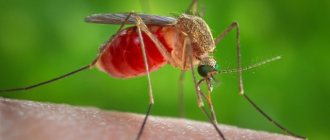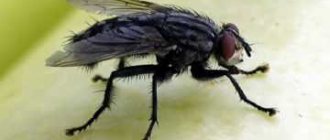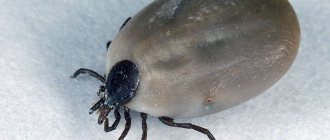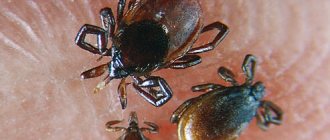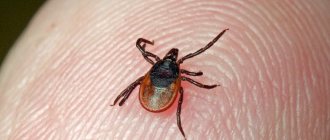How ticks live and bite
Ixodid ticks are specialized blood-sucking parasites of animals and humans, the largest representatives of the genus. In the warm season - from early spring to early autumn - it is they who begin the “hunt”.
Ticks are active and bite people and animals from spring to autumn
Many are convinced that ticks can only be found in forests, but this is not true. The parasite can be introduced into the urban environment with flowers, brushwood, and domestic animals (for example, dogs or cattle). There are known and not isolated cases of tick attacks in public gardens and parks. Ticks inhabit animal habitats, pastures, paddocks and wait for victims there. It is preferable for the parasite to hunt in bushes, grass and other low vegetation - this way it can easily and, most importantly, quickly climb onto the victim at the first favorable opportunity.
Having settled in ambush, the tick waits for the victim for quite a long time: in the spring, after winter hibernation, it begins to hunt; if there is no prey during the warm period, with the onset of cold weather it again goes “for the winter” until spring, after which it “wakes up” and continues to hunt.
A hungry tick can spend whole days, weeks and months waiting for a victim, falling into suspended animation during the winter.
Thanks to its well-developed sense of smell, it detects the approach of a potential host at a distance of up to 10 meters by earth vibrations, heat and smell. Having sensed “prey”, the tick, like antennae, extends its forelimbs forward in order to accurately grasp the direction of movement of the victim and latch onto it when it is nearby.
Once on the “host”, the mites spend a long time, sometimes for hours, searching for places of suction . Their oral organ has the appearance of a head sticking forward, adapted for cutting the skin and firmly and long-term fixation on the host’s body.
The tick does not bite immediately; it can spend 1–2 hours choosing the most tender place to bite
Thanks to the action of a natural anesthetic in saliva, bites are painless. Adult ticks suck blood from 1 to 12 days. The duration of the bite will be influenced by a number of factors: the developmental phase of the tick, gender, how long it will bite through the skin . These nuances are discussed in more detail below.
There is information that for the first 12 hours it pierces the skin and does not yet suck blood. But you should understand that this is inaccurate information, if only because the skin of a person has different thicknesses in different places, and in a child it will, in principle, be thinner than in an adult. Therefore, it is better to carry out inspections as often as possible.
After 1–2 days from the start of the bite, a feeling of slight nagging pain occurs, as a local inflammatory reaction develops at the site of suction, sometimes accompanied by suppuration. The bite wound heals slowly and is very itchy.
Benefits of arachnids
Despite the fact that people are prejudiced against ticks, there are still benefits from them. In nature and in various industries, they can provide significant assistance:
- While causing enormous damage to agriculture, they still have a positive role. Being mostly saprophages in their diet, they improve the soil by feeding on the decaying remains of plants and animals.
- Predatory representatives of this class are used to exterminate other arachnids, which suck all the juice from plants, destroying most of the crop.
- They can also rid a plant affected by spores of parasitic fungi.
- Scientists have long been interested in the enzymes contained in the saliva of arthropods. Anticoagulants, as they are also called, prevent blood clotting.
- Some types of cheese are made by attaching a microscopic mite to the rind of the product at the beginning of its ripening. This allows cheese makers to obtain a unique pattern and specific aroma, makes it porous, which allows the cheese to breathe throughout the entire ripening process.
Representatives of the arachnid class are part of the food chain and an important link in the ecosystem. For example, the favorite delicacy of some birds and frogs is ixodid ticks.
Life cycle of a tick
The tick goes through several stages of development and changes through three hosts during its life.
The life cycle of a tick goes through four stages:
- Egg.
- Larva.
- Nymph.
- Adult: male, female.
Whether the parasite will go through all stages of development in one warm season depends on the following factors:
- successful “hunt” - the tick needs to change three hosts to move to the next stage of development;
- climatic conditions in the region - in the cold season the parasite slows down life processes and remains in suspended animation.
At all stages of development, ticks feed exclusively on the blood and lymph of animals and humans.
Larva
If the female tick is saturated with blood, then from late spring to early summer she will produce a clutch of 2-3 thousand eggs. After 2–4 weeks, larvae will appear.
The female tick lays eggs
The integument of the larvae's body has not yet been formed, the shell is thin and translucent, there are three pairs of limbs, however, already at this stage of development all the outlines of an adult are present.
The size of the larvae does not exceed 0.5 mm. It is difficult for them to climb to heights, so they have to hunt small terrestrial animals: voles, rats, hedgehogs. Having chosen a victim, the larva climbs onto it, attaches itself and begins to feed.
The duration of blood sucking of the moth is from 2 to 6 days, until complete saturation . A well-fed larva does not live on the host; at the end of the meal, it detaches and falls into the soil for further development. The stage of transformation into a nymph begins.
If at the end of the warm season the victim is not encountered, the tick will overwinter in the larval stage. Severe winters, frosts of -5°C and below can kill the larva. If the winter has been relatively warm, with the arrival of spring she will go hunting again.
A hungry larva, waiting for food, can live up to 2 years.
The life cycle of a tick lasts several seasons
Nymph
A nymph is an intermediate stage of tick development, something like a teenager, no longer a larva, but not yet an adult.
The parasite increases in size - the length now reaches from 1 to 2 mm, a pair of limbs is added - there are four of them, thanks to which the nymph moves much faster than the larva and can afford to hunt larger animals, for example, hares.
Already at the nymph stage, ticks show aggression towards humans; if they meet, they will try to attack him.
To quench the thirst of hunger, the nymph needs to “eat” from 3 to 8 days . After complete saturation, it becomes detached from the victim and disappears. With the help of drinking blood, a new stage of development begins - transformation into an adult.
Like the larva, the nymph can be destroyed by severe frosts, but if this does not happen, its hunt will continue in the spring. In a favorable environment, a nymph in a hungry state is viable for up to 2–3 years .
Adult
When sucking blood, the tick swells to gigantic size.
Ticks become males and females only in the adult stage. The size of a hungry parasite reaches 3–5 mm and directly depends on the sex of the individual—females are larger than males. The main goal of an adult tick is reproduction. Ticks hunt large animals and humans.
If a person is attacked by a tick, the duration of blood sucking will depend on the gender of the parasite. For high-quality egg laying and reproduction of healthy offspring, females need to pump 5–7 times more blood than males. Adult female ticks are capable of sucking blood for up to 12 days . The female’s body is designed in such a way that the hard shell only covers half of it; the other half is a kind of sac that can swell and contain an amount of blood that is 300–500 times greater than the tick’s own size. This is necessary for high-quality egg laying - only after fully “quenching her hunger” is the female able to lay eggs.
The male’s body is completely covered with a hard shell - it does not swell when sucking blood, and accordingly the amount of blood he drinks will be much less, and the “meal” will be modest and quick. The male tick drinks blood from 1 to 3 days .
Adults are quite hardy - severe frosts are unable to exterminate them; during the cold period they simply go into hibernation, and as the weather gets warmer they wake up and go hunting.
The external manifestation of the characteristics of the tick’s life cycle is the transformation of the body into a soft, voluminous bag that can stretch and swell when sucking blood.
Ticks do not use animals or humans as a permanent host to live and reproduce on them; they prefer the forest floor. They only need a sufficient portion of blood from the victim, upon receiving which they immediately detach . Cases of reproduction on the host are extremely rare. As a rule, ticks look for each other in natural conditions.
When saturated, the body of a female tick turns into a soft, voluminous sac.
How long can ticks live on the host's body?
How long ticks live on the body of an animal or person depends on how quickly they suck blood. The life phase has several stages:
- first the parasite attacks a victim from grass, bush or tree;
- then selects the place where the skin is thinnest;
- attaches, injects a substance that numbs the bite site and begins to feed on blood;
- detaches for reproduction.
The ixodid species needs nutrition once during the active phase of its life cycle, so they live on the body for up to two weeks. Females drink blood longer than males. People usually discover ticks before the parasite has a chance to lay offspring. But don't worry, larvae cannot develop on human skin due to its thickness.
The Argasid type of tick often bites people at night; it does not stay on the body for more than two hours. The larvae can remain for about five days and then begin to molt.
There are scabies mites that live on the human body and provoke the development of scabies. They are contagious and can be transmitted through personal items, as well as from animals. This mite (itch) does not live long on humans, and the number of parasites depends on the immunity of people. Scabies mites cannot live outside the host’s body, on clothing or in the external environment; they die quickly enough.
The encephalitis tick can be of any type; it is called so because it carries the causative agent of encephalitis - a very dangerous disease. A tick bite is the most common way of contracting the disease. A complication of encephalitis is death after meningitis as a complication. If an infected tick has already bitten someone, then it will no longer live; the main thing is to remove it correctly so that the proboscis and head are not left in the wound.
The ear mite, which mainly affects animals, is rarely found on the human body and lives no more than two months. It gets into people's homes on clothes, shoes, vegetables and fruits.
How many years do ticks live?
The main, and indeed the only, goal of this parasite, the simplest in structure, is to find a host, pump blood for further development, become an adult and continue the race. The female dies after laying eggs, the male dies after fertilizing 1-2 females . In a favorable year in a warm southern climate, ticks are capable of producing two offspring in one season. After reproduction they die.
Nature has endowed the tick with endurance - in conditions of famine and favorable climatic conditions, it is viable for up to 2-3 years.
The high fecundity of ticks compensates for the noticeable mortality caused by a shortage of hosts.
Lifespan of a tick without feeding
Arachnids are quite hardy. How long ticks live without food depends on climatic conditions. The main role is played by the temperature and humidity of the ambient air. But their average life expectancy is:
- for adult individuals of the argasid species 2.5–12 years, larvae live no more than 2 years;
- Ixodid ticks live 8 months -5 years, larvae also no more than 2 years.
Ticks tolerate harsh conditions well; the state of suspended animation saves them from death. All life processes occur at a slow pace. The tick remains in this state without blood for up to 10 years. As soon as it lands on the victim’s body, it begins to suck blood, when it is satiated, it detaches.
Ticks on the human body
Why is a tick dangerous?
When hosts change, conditions are created for the transfer of pathogens. The virus obtained from wild animals accumulates in the tick's body and penetrates the salivary glands. The duration of blood sucking directly affects the continued growth of the glands and the number of viral particles multiplying in them. With prolonged blood sucking, more viruses enter the blood, so if you find a tick on your body, it is important to immediately remove it and submit it to a laboratory to check for viruses .
Ticks are carriers of dangerous microbes and can transmit dangerous diseases, such as:
- borreliosis (Lyme disease);
- tick-borne encephalitis;
- tick-borne relapsing fever;
- ehrlichiosis;
- babesiosis;
- tularemia;
- spotted fever.
These diseases are dangerous for both animals and humans, as they can lead to disability and even death.
Among domestic animals, goats are the most susceptible to encephalitis. Human infection with tick-borne encephalitis virus can occur through raw goat milk.
